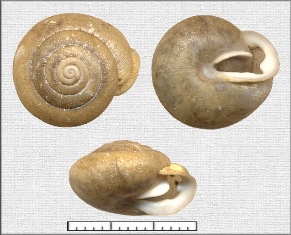Classification
Domain: Eukarya
Kingdom: Animalia
Phylum: Mollusca
Class:
Gastropoda
Order: Stylommatophora
Family: Polygyridae
Genus: Inflectarius
Species: Inflectarius smithi
(G.H. Clapp, 1905)
Common Name: Alabama shagreen
This information was found at ITIS Report, to visit the site or look for more classification information, visit their website.
The species name for Inflectarius smithi can be broken down into different Latin roots. Inflecto can stand for to warp, change, sway, bend, bow or curve. To learn more english translations from Latin, go to the Latin-English Translator. The last part of the species name, smithi, means that the species was named after the person who discovered it, Smith.
The common name simply arose from the state it is
most commonly found in, Alabama. Shagreen is a word
for untanned leather that has a rough surface
texture, which the shell of the Inflectarius
smithi is similar to. To see the definitions
for shagreen, go to
Dictionary.Reference.com.
How Inflectarius
smithi
fits into these categories...
Eukarya: Cells are more complex and structurally
organized than those of Archaea and Eubacteria (Encyclopedia
of Life, 2012).
Organelles are bound by membranes, and the nucleus
is membrane bound (EOL,
2012).
The name ‘eu-karyote’ means ‘true kernel’, referring
to the membrane bound nucleus that the Archaea and
Eubacteria groups lack (EOL,
2012).
Animalia: Multicellular organisms
that lack cell walls that the Kingdom Plantae has (EOL,
2012).
They are heterotrophic, meaning they have to find
their own food instead of producing their own food,
such as plants do through photosynthesis (EOL,
2012).
Their locomotion is through muscles bound to the
skeletal system, tissues and nerves (EOL,
2012).
Most of the Kingdom Animalia reproduce sexually, but
there are a select few that do asexual reproduction
(EOL, 2012).
Mollusca: This Phylum is well known
for their muscular foot, which can be used for
locomotion, attaching to surfaces,
digging/burrowing, anchoring, swimming and grasping
(EOL, 2012). Because of all
these various forms of the muscular foot, it
produces the great variety seen in the Mollusca
Phylum (EOL, 2012). They have
a layer of epidermal tissue called the mantle that
helps to form the shell that most of these animal
have (EOL, 2012). Their
habitats range from freshwater, moist terrestrial
areas, and marine waters (EOL,
2012).
Gastropoda: This class contains the
snails and slugs, where they either have the
spiraled shell or not (EOL,
2012).
Torsion takes place in this class during the larval
stage, where the body is twisted to place the anus
near the mouth, making it so they only have one
opening to close when being attacked by predators (EOL,
2012).
Gastropods use their muscular foot to slowly creep
along, in some it is modified for swimming or
digging (EOL, 2012).
Sexually, this Class can either self fertilize
(dioecious) or exchange sperm bundles or engage in
copulation (hermaphroditic) (EOL,
2012).
Stylommatophora: Terrestrial
Gastropods that have two pairs of tentacles that can
be retracted inwards; the uppermost pair contain the
eyes at the end (EOL, 2012).
Most of the animals in this order have shells, but
some do not possess any (EOL,
2012).
Polygyridae: This family is made up
of air-breathing land snails that are easily found
in eastern and western North America, northern
Central America and also the Caribbean Islands (EOL,
2012).
Inflectarius: This genus contains
air-breathing lands snails that are located mainly
in the eastern part of North America (BOLDsystems,
2012). As one can see in the picture to the
right of the Inflectarius smithi shell,
they are of a relatively small size and the whorls
of its shell are rather flattened. The opening to
the shell is small, due to the large sizes of the
lip and teeth of the shell.
To learn more about the habitat of this small snail, go to the
Habitat page where specific information is
given to where it is located in North America.
